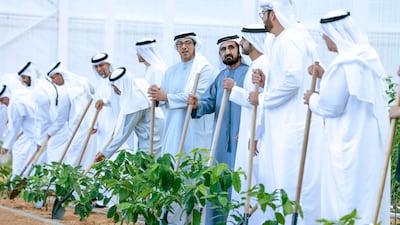It is not every day that one sees some of country’s leading figures lined up, spades in hand, preparing for work on a farm. And yet this was the intriguing image that emerged from the recent launch of a national agriculture drive aimed not only at further securing the UAE’s food supply but at encouraging citizens and residents alike to grow more of their own produce.
Al Marmoom farm in Dubai on Sunday played host to Sheikh Mohammed bin Rashid, Vice President and Ruler of Dubai. Alongside him were Vice President, Deputy Prime Minister and Chairman of the Presidential Court Sheikh Mansour bin Zayed as well as the Crown Prince of Dubai, Deputy Prime Minister and Minister of Defence, Sheikh Hamdan bin Mohammed. They and other ministers were coming from a Cabinet meeting where the new project – Plant the Emirates – had been launched.
Plant the Emirates envisages a new National Agriculture Centre and other initiatives to further develop advanced farming technology, improve yields and quality, build links with the private sector and increase the number of farms and agricultural workers in the UAE. Importantly, it will also encourage people to develop green fingers by growing food at home.
Although it is true that agriculture is not new to the Emirates – people have farmed here for generations, often coming up with innovative ways of maximising yields despite low water supply and arid conditions – challenges remain. The UAE’s largely desert environment and the risks posed to supply chains by pandemics or international disruptions are particularly acute. And although the proportion of food that the Emirates imports is declining, the country is not yet self-sufficient.
Therefore, it is vital to get as many people as possible on board with new ways of thinking about food. The major strides in Emirati agriculture that have been made over the decades, including last year’s high-tech wheat-growing project at a 400-hectare farm complex in Sharjah and last month’s large-scale quinoa cultivation trials, will be even more effective if the population plays an active role in growing and producing. The UAE’s rapid urbanisation need not be a barrier to this: one need only consider the success of the allotment system in the UK or rooftop farming in built-up Hong Kong.
The drive to secure and improve food supplies in the UAE is as old as the country itself
Encouraging people to play their part could also change attitudes to consumption. Data last year from the UAE’s first national household food waste survey found that 38 per cent of food prepared went to waste at a cost of $163.3 million and Ne’ma, the UAE’s national food loss and waste initiative, is driving efforts to reduce food waste by 50 per cent by 2030. Building a closer link between people and their food is an important step in improving these figures.
Another important benefit is that of health and developing better eating habits, with fresh produce being instrumental to that drive.
The push to secure and improve food supplies in the UAE is as old as the country itself. Sheikh Mohammed reflected on this when he said the Plant the Emirates project “carries forward the legacy of the late Sheikh Zayed bin Sultan Al Nahyan, the UAE Founding Father, fulfilling his vision to green, cultivate, and nurture the land of the UAE”. That vision is being brought nearer by 21st-century technology and innovation – often presenting credible investment opportunities for domestic and international companies. But for it to really take root, more of us should grow our own.
WOMAN AND CHILD
Director: Saeed Roustaee
Starring: Parinaz Izadyar, Payman Maadi
Rating: 4/5
Mohammed bin Zayed Majlis
UAE currency: the story behind the money in your pockets
Scoreline:
Everton 4
Richarlison 13'), Sigurdsson 28', Digne 56', Walcott 64'
Manchester United 0
Man of the match: Gylfi Sigurdsson (Everton)
Coal Black Mornings
Brett Anderson
Little Brown Book Group
It Was Just an Accident
Director: Jafar Panahi
Stars: Vahid Mobasseri, Mariam Afshari, Ebrahim Azizi, Hadis Pakbaten, Majid Panahi, Mohamad Ali Elyasmehr
Rating: 4/5
How will Gen Alpha invest?
Mark Chahwan, co-founder and chief executive of robo-advisory firm Sarwa, forecasts that Generation Alpha (born between 2010 and 2024) will start investing in their teenage years and therefore benefit from compound interest.
“Technology and education should be the main drivers to make this happen, whether it’s investing in a few clicks or their schools/parents stepping up their personal finance education skills,” he adds.
Mr Chahwan says younger generations have a higher capacity to take on risk, but for some their appetite can be more cautious because they are investing for the first time. “Schools still do not teach personal finance and stock market investing, so a lot of the learning journey can feel daunting and intimidating,” he says.
He advises millennials to not always start with an aggressive portfolio even if they can afford to take risks. “We always advise to work your way up to your risk capacity, that way you experience volatility and get used to it. Given the higher risk capacity for the younger generations, stocks are a favourite,” says Mr Chahwan.
Highlighting the role technology has played in encouraging millennials and Gen Z to invest, he says: “They were often excluded, but with lower account minimums ... a customer with $1,000 [Dh3,672] in their account has their money working for them just as hard as the portfolio of a high get-worth individual.”
Company%20profile
%3Cp%3E%3Cbr%3E%3Cstrong%3EName%3A%3C%2Fstrong%3E%20Khodar%3Cbr%3E%3Cstrong%3EBased%3A%3C%2Fstrong%3E%20Cairo%20and%20Alexandria%2C%20in%20Egypt%3Cbr%3E%3Cstrong%3EFounders%3A%3C%2Fstrong%3E%20Ayman%20Hamza%2C%20Yasser%20Eidrous%20and%20Amr%20El%20Sheikh%3Cbr%3E%3Cstrong%3ESector%3A%3C%2Fstrong%3E%20agriculture%20technology%3Cbr%3E%3Cstrong%3EFunding%3A%3C%2Fstrong%3E%20%24500%2C000%3Cbr%3E%3Cstrong%3EInvestors%3A%3C%2Fstrong%3E%20Saudi%20Arabia%E2%80%99s%20Revival%20Lab%20and%20others%3Cbr%3E%3Cstrong%3EEmployees%3A%3C%2Fstrong%3E%2035%3C%2Fp%3E%0A
Why%20all%20the%20lefties%3F
%3Cp%3ESix%20of%20the%20eight%20fast%20bowlers%20used%20in%20the%20ILT20%20match%20between%20Desert%20Vipers%20and%20MI%20Emirates%20were%20left-handed.%20So%2075%20per%20cent%20of%20those%20involved.%0D%3Cbr%3EAnd%20that%20despite%20the%20fact%2010-12%20per%20cent%20of%20the%20world%E2%80%99s%20population%20is%20said%20to%20be%20left-handed.%0D%3Cbr%3EIt%20is%20an%20extension%20of%20a%20trend%20which%20has%20seen%20left-arm%20pacers%20become%20highly%20valued%20%E2%80%93%20and%20over-represented%2C%20relative%20to%20other%20formats%20%E2%80%93%20in%20T20%20cricket.%0D%3Cbr%3EIt%20is%20all%20to%20do%20with%20the%20fact%20most%20batters%20are%20naturally%20attuned%20to%20the%20angles%20created%20by%20right-arm%20bowlers%2C%20given%20that%20is%20generally%20what%20they%20grow%20up%20facing%20more%20of.%0D%3Cbr%3EIn%20their%20book%2C%20%3Cem%3EHitting%20Against%20the%20Spin%3C%2Fem%3E%2C%20cricket%20data%20analysts%20Nathan%20Leamon%20and%20Ben%20Jones%20suggest%20the%20advantage%20for%20a%20left-arm%20pace%20bowler%20in%20T20%20is%20amplified%20because%20of%20the%20obligation%20on%20the%20batter%20to%20attack.%0D%3Cbr%3E%E2%80%9CThe%20more%20attacking%20the%20batsman%2C%20the%20more%20reliant%20they%20are%20on%20anticipation%2C%E2%80%9D%20they%20write.%0D%3Cbr%3E%E2%80%9CThis%20effectively%20increases%20the%20time%20pressure%20on%20the%20batsman%2C%20so%20increases%20the%20reliance%20on%20anticipation%2C%20and%20therefore%20increases%20the%20left-arm%20bowler%E2%80%99s%20advantage.%E2%80%9D%0D%3Cbr%3E%3C%2Fp%3E%0A





